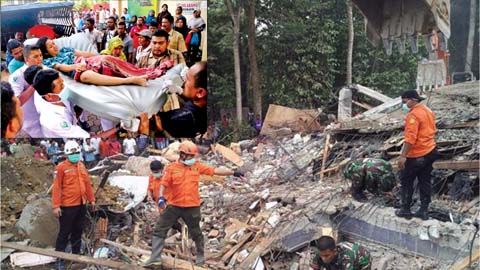
The Telegraph :
A strong undersea earthquake rocked Indonesia’s Aceh province early on Wednesday, killing over 97 people and sparking a frantic rescue effort in the rubble of dozens of collapsed and damaged buildings.
Maj Gen Tatang Sulaiman, chief of the army in Aceh province, said at least 97 died while four people were pulled from the rubble alive. Most of the deaths were in in Pidie Jaya, the district closest to the epicentre.
Another four or five people are still believed to be buried, but it is not known if they are dead or alive.
“Hopefully we would be able to finish the evacuation from the rubble before sunset,” said Sulaiman.
The National Disaster Mitigation Agency said 273 people were injured, about a quarter of them seriously.
Some 245 buildings were seriously damaged or destroyed, mostly in Pidie Jaya, including 14 mosques and the remainder largely dwellings and shop houses. Roads also cracked and power poles toppled over.
The rescue effort involving villagers, soldiers and police is concentrated on Meureudu, a severely affected town in Pidie Jaya district. Excavators were trying to remove debris from shop houses and other buildings where people were believed buried. TV footage showed rescue personnel taking bodies in black bags away from the rubble.
The US Geological Survey said the shallow 6.5-magnitude earthquake that struck at 5:03am (22.03 GMT on Tuesday) was centered about 6 miles (10km) north of Reuleut, a town in northern Aceh, at a depth of 11 miles (17km). It did not generate a tsunami.
For Acehnese, the quake was another terrifying reminder of their region’s vulnerability to natural disasters. More than 100,000 died in Aceh after the December 26, 2004, earthquake triggered a devastating tsunami.
“It was very bad, the tremors felt even stronger than 2004 earthquake,” said Musman Aziz, a Meureudu resident. “I was so scared the tsunami was coming.”
In the capital Jakarta, President Joko ‘Jokowi’ Widodo said he has ordered all government agencies to take part in the rescue efforts. Seaside resident Fitri Abidin in Pidie Jaya said she fled with her husband and wailing children to a nearby hill after the quake jolted the family awake early in the morning. They stayed there for several hours until authorities reassured them there was no tsunami risk. “It terrified me. I was having difficulty breathing or walking,” said Abidin. She said her husband grabbed hold of her and carried her out of the house.
The family’s house didn’t collapse but the homes of some neighbours did and Abidin is afraid three friends were buried in building collapses. In Pidie Jaya’s neighboring district of Bireuen, a teacher at an Islamic building school died after being hit by falling debris.
About 20 people were being treated at a health center and one person was moved to a hospital because of broken bones and a head injury, health worker Achmad Taufiq said.Residents of the nearby town of Lhokseumawe ran out of their houses in panic during the quake and many people fled to higher ground.
Aceh lies on the northern tip of Sumatra island, which is particularly prone to earthquakes.
In June, a 6.5-magnitude quake struck off the west of Sumatra, damaging scores of buildings and injuring eight people. The world’s largest archipelago, Indonesia is prone to earthquakes due to its location on the Pacific “Ring of Fire,” an arc of volcanoes and fault lines in the Pacific Basin. The 2004 quake and tsunami killed a total of 230,000 people in a dozen countries, most of them in Aceh.

